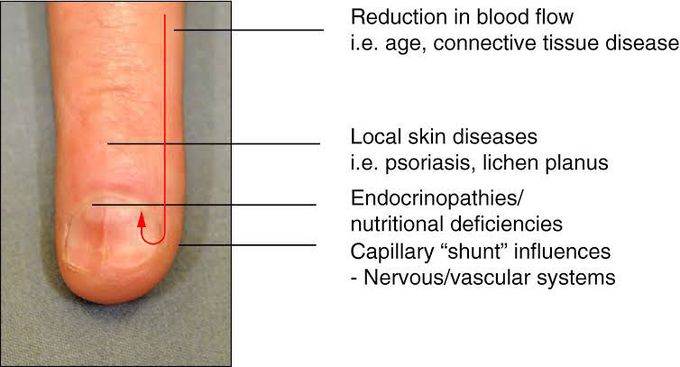


All about Spoon Fingers - aka Koilonychia
Koilonychia - Spoon-shaped or spooning fingernails refers to a concavity in the fingernail, resulting in a depression in the nail that gives an appearance of a spoon shape to the entire nail. The spooning is typically such that a water droplet may be placed and held in the depression within the nail. This pattern can sometimes be seen in normal infants, but it disappears as the child ages. Causes Koilonychia is often a sign of another condition but sometimes, there is no clear cause. Nutrition deficiency Iron deficiency is the most frequent cause of koilonychia. Following health problems can lead to an iron deficiency: • too little iron in the diet • inability to absorb enough iron from food • malnutrition • bleeding in the intestinal tract • cancer • celiac disease People who do not consume enough folate, protein, and vitamin C can also develop an iron deficiency. People with Plummer-Vinson syndrome may have koilonychia. This condition can affect those with long term iron deficiency. Autoimmune conditions Koilonychia can occur with: • systemic lupus erythematosus (SLE), or lupus • some inflammatory skin conditions, such as psoriasis and lichen planus. In psoriasis, a problem with the immune system can lead to nail and skin changes. Environmental exposures There may be a link between koilonychia and products that contain petroleum. People that live at high elevations may also have a higher risk of developing koilonychia. (air at higher altitudes -> less oxygen than it does at lower levels -> body produces extra red blood cells -> needs iron to do this ->leave the body short of iron.) In addition to the altitude, the traditional diet of those living in this region is low in iron. This further increases their risk of koilonychia. Genetic factors Koilonychia can occur as a result of some genetic conditions. These include: • Hemochromatosis: The person absorbs too much iron from their diet. • Nail-patella syndrome: A person can have problems with their nails, kneecaps, hip bones, and elbows. Other conditions Koilonychia has links with the following conditions: • low blood supply to the extremities, as with Raynaud’s disease • cardiovascular problems • hypothyroidism • nail trauma • vitamin B deficiency • celiac disease Symptoms Flat nails can be an early sign of koilonychia. Nails tend to flatten before developing the characteristic concave shape. Most nails curve down and are convex. When the nails become concave, they are able to hold a drop of water on the top of the nail. The changes are often easier to spot on fingernails rather than toenails. Risk factors People who have a higher risk of koilonychia include: • older people • those who have low blood flow to their fingers and toes • women during menstruation • anyone with a higher risk of iron deficiency • people with lupus • people with an eating disorder or malnutrition • people who follow a vegetarian or vegan diet • those who work with petroleum-based solvents Treatment and prevention Treatment will depend on the cause of koilonychia. Some causes will respond to dietary changes. Consuming enough iron in the diet can also help prevent unwanted nail changes. In some cases, iron deficiency resolves with dietary changes. A person may need to eat more food that contains iron, or they may need iron supplements. Combining plant based sources of iron with vitamin C rich foods, such as citrus fruits, can help increase iron absorption. Good sources of iron include: • fortified breakfast cereals, which may contain 100% of the daily requirement in just one serving • other fortified foods, such as bread and enriched rice • dark chocolate • beans, lentils, and chickpeas • beef, especially beef liver • tofu • leafy greens • baked potato • cashews Wanna feel nostalgic? Popoy, the sailor man, ate spinach and had the strongest body and nails!
Living with Lupus is often a battle not just against the illness itself, but also against the emotional weight of uncertainty, fatigue, and the toll of long-term medications. For one courageous woman, that battle began in 2013. Diagnosed after Lupus had already affected her joints and internal organs, she was quickly placed on medication that initially helped. But as time went on, her health declined again this time with more frequent flare-ups and increasingly difficult side effects. Like many others with chronic illness, she faced the crushing weight of hopelessness. Each day became harder than the last, and conventional treatments no longer offered the comfort they once did. But in March 2020, at her lowest point, she made a decision that changed everything.Out of desperation and with a healthy dose of skepticism she turned to NaturePath Herbal Clinic, hoping their natural Lupus treatment might offer at least some relief. What happened next went far beyond her expectations.After completing a six-month herbal program, her flare-ups stopped entirely. Her energy returned. The chronic pain that had defined her daily life began to fade. For the first time in years, she felt like herself again. Not just alive but truly living.Her story is not just one of healing; it’s one of resilience, open-mindedness, and the courage to try something new when all else fails. By sharing her journey, she hopes to offer something priceless to others living with Lupus: hope.This treatment has been a true breakthrough for her. If you’re searching for a safe, natural, and effective alternative, I genuinely recommend giving this a chance.”www.naturepathherbalclinic.com or email them at info@naturepathherbalclinic.com


